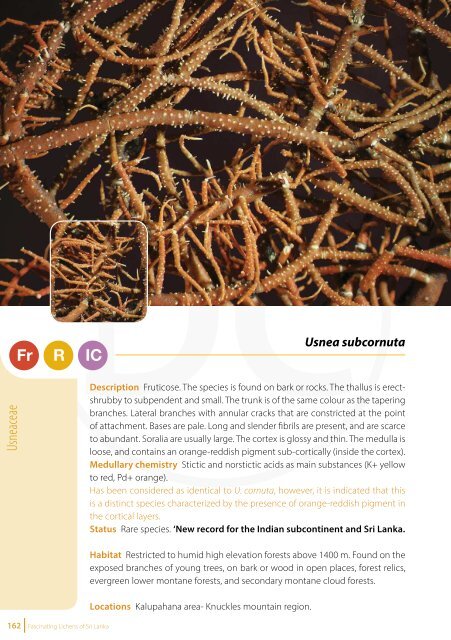Fascinating Lichens of Sri Lanka
Fascinating Lichens of Sri Lanka
Fascinating Lichens of Sri Lanka
- No tags were found...
You also want an ePaper? Increase the reach of your titles
YUMPU automatically turns print PDFs into web optimized ePapers that Google loves.
5. Graphidaceae:<br />
the most speciose lichen<br />
family in <strong>Sri</strong> <strong>Lanka</strong><br />
Genera 103+<br />
Ostropales Graphidaceae<br />
c.2500<br />
Graphidaceae is the largest family <strong>of</strong> tropical crustose lichens, with 103 genera<br />
known to date comprising 2500 accepted species. Recent phylogenic and<br />
statistical analysis showed that <strong>Sri</strong> <strong>Lanka</strong> and South India are the Graphidaceae<br />
hotspots in the world with 499 species (Lücking et al. 2014).<br />
Usneaceae<br />
Fr R IC<br />
Usnea subcornuta<br />
Description Fruticose. The species is found on bark or rocks. The thallus is erectshrubby<br />
to subpendent and small. The trunk is <strong>of</strong> the same colour as the tapering<br />
branches. Lateral branches with annular cracks that are constricted at the point<br />
<strong>of</strong> attachment. Bases are pale. Long and slender fibrils are present, and are scarce<br />
to abundant. Soralia are usually large. The cortex is glossy and thin. The medulla is<br />
loose, and contains an orange-reddish pigment sub-cortically (inside the cortex).<br />
Medullary chemistry Stictic and norstictic acids as main substances (K+ yellow<br />
to red, Pd+ orange).<br />
Has been considered as identical to U. cornuta, however, it is indicated that this<br />
is a distinct species characterized by the presence <strong>of</strong> orange-reddish pigment in<br />
the cortical layers.<br />
Status Rare species. ‘New record for the Indian subcontinent and <strong>Sri</strong> <strong>Lanka</strong>.<br />
Habitat Restricted to humid high elevation forests above 1400 m. Found on the<br />
exposed branches <strong>of</strong> young trees, on bark or wood in open places, forest relics,<br />
evergreen lower montane forests, and secondary montane cloud forests.<br />
Locations Kalupahana area- Knuckles mountain region.<br />
This is the most speciose lichen family in <strong>Sri</strong> <strong>Lanka</strong> with c.400 species known<br />
from over 40 genera. More than 175 species in this family are new records for the<br />
country (Weerakoon et al. in preparation). Since 2012, over 42 new species have<br />
been discovered in family Graphidaceae by local lichenologists from <strong>Sri</strong> <strong>Lanka</strong><br />
(Weerakoon et al. 2012 a & b; Weerakoon et al. 2014; Weerakoon et al. A in press,<br />
Wijeyaratne et al. 2012). Out <strong>of</strong> the recently described species, 97% are endemic<br />
to <strong>Sri</strong> <strong>Lanka</strong>, with majority retaining point endemics.<br />
Hale’s (1981) extensive monograph <strong>of</strong> the species, which at the time included<br />
Thelotremataceae, but now forms part <strong>of</strong> the Graphidaceae, no doubt represents<br />
the turning point <strong>of</strong> monographic work on lichen fungi in <strong>Sri</strong> <strong>Lanka</strong>. Several<br />
recent publications now in press (Weerakoon et al. 2014; Weerakoon et al. A, &<br />
B, in preparation) continue the inventory <strong>of</strong> the Graphidaceae <strong>of</strong> the country,<br />
confirming the extraordinary diversity in <strong>Sri</strong> <strong>Lanka</strong>.<br />
As the family is extremely diverse and includes over 40 genera, trained<br />
lichenologists should identify the species using advanced morphological and<br />
chemical characters. Most <strong>of</strong> the species are inconspicuous crustose lichens<br />
in Graphidaceae, therefore only a few conspicuous species that are within the<br />
reach <strong>of</strong> the casual observer in natural habitat are included in this book. Except<br />
for the genus Diploschistes (single most easily identified species known for <strong>Sri</strong><br />
<strong>Lanka</strong>), generic and species descriptions are not given. Readers who wish to<br />
confidently identify the species <strong>of</strong> this family should use recent keys. However, I<br />
hope the colourful photos included in the book will give you an idea about the<br />
diversity <strong>of</strong> family Graphidaceae in <strong>Sri</strong> <strong>Lanka</strong>.<br />
Graphidaceae<br />
162 <strong>Fascinating</strong> <strong>Lichens</strong> <strong>of</strong> <strong>Sri</strong> <strong>Lanka</strong><br />
<strong>Fascinating</strong> <strong>Lichens</strong> <strong>of</strong> <strong>Sri</strong> <strong>Lanka</strong> 163
















